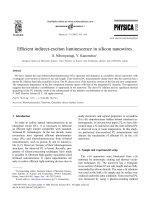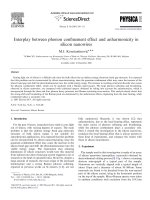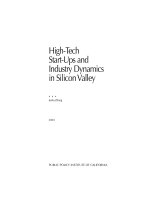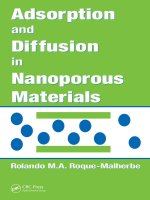- Trang chủ >>
- Khoa Học Tự Nhiên >>
- Vật lý
BORON AND PHOSPHORUS DIFFUSION IN SILICON INTERSTITIAL, VACANCY AND COMBINATION MECHANISMS
Bạn đang xem bản rút gọn của tài liệu. Xem và tải ngay bản đầy đủ của tài liệu tại đây (422.64 KB, 7 trang )
Proc. Natl. Conf. Theor. Phys. 35 (2010), pp. 73-79
BORON AND PHOSPHORUS DIFFUSION IN SILICON:
INTERSTITIAL, VACANCY AND COMBINATION MECHANISMS
VU VAN HUNG
Hanoi National University of Education, 136 Xuan Thuy Street, Hanoi
PHAN THI THANH HONG
Hanoi Pedagogic University No-2, Xuan Hoa, Phuc Yen, Vinh Phuc
BUI VAN KHUE
Hai Phong University, 171 Phan Dang Luu, Kien An, Hai Phong
Abstract. The diffusion of boron B and phosphorus P in silicon has been investigated by using the statistical moment method (SMM). Temperature dependence of activation energy, Q, and
diffusion coefficient, D, of B and P in silicon obey interstitial, vacancy and combination mechanisms has been studied. The effects of anharmonicity and the different mechanisms on diffusion
of B and P in silicon are calculated. Experimental results for B and P diffusion in silicon and
SMM calculations of the activation energy for B and P diffusion by interstitial mechanism are in
quantitave agreement.
I. INTRODUCTION
IC (Integrated Circuit) fabrication is accomplished by selectively changing the electrical properties of silicon through the introduction of impurities commonly referred to
as dopants. In recent years, integrated circuit fabrication, deep semiconductor junctions
required doping processes followed by a drive-in step to diffuse the dopants to the desired
depth, i.e. diffusion was required to successfully fabricated devices. In modern state-ofthe-art IC fabrication the required junction depths have become so shallow that dopants
are introduced into the silicon at the desired depth by ion implantation and any diffusion
of the dopants is unwanted. Therefore, atomic processes of impurity diffusion in Si are
of great scientific and technological interest. In particular, the problem of identifying the
dominant diffusion mechanism has attracted considerable attention [1]. Both experimental observations and theoretical calculations indicate that diffusion of common dopants in
Si mediated by interstitials (I), vacancies (V) or a concerted exchange (CE) mechanism
[2, 3, 4, 5, 6, 7].
The development of theoretical calculations of atomic diffusion in silicon is of great
interest. Namely, The First-principles total-energy calculations [2, 3], the Ab initio calculations [4, 8], the Tight-binding molecular dynamics (TBMD) [9], the Density functional
theory (DFT) [10], the Local density approximation (LDA) [11],...In these papers, authors
has been studied diffusion of impurities: B, P, As, Sb,... in silicon, calculated activation
energy for an atom diffusion. They find that B, P, and As diffusion have substantial interstitial components, while Sb diffusion is vacancy dominated. Parallel with theoretical
74
VU VAN HUNG, PHAN THI THANH HONG, BUI VAN KHUE
methods, the diffusivity of dopant impurities in silicon have been measured. Instance for,
the Secodary ion mass spectrometry (SIMS) [6, 7], the Radioisotope [12],...
In order to understand the diffusion of impurities in silicon, one should be carefull
to study the local behavior of impurities close to the vacancy and the interstitial. In
the present study we used the moment method in statistical dynamics within the fourth
order moment approximation, to calculated the activation energy, Q, pre-exponential, D0 ,
and diffusion coefficient, D, of B and P in silicon at zero pressure. We also compare the
calculated results for diffusion of B and P in silicon with the experimental data and the
different theortical calculations.
II. THEORY
Impurity atoms may occupy either substitutional or interstitial positions in the Si
lattice. Vacancy diffusion occurs when a substitutional atom exchanges lattice positions
with a vacancy- requires the presence of a vacancy. Interstitial diffusion occurs when
an interstitial atom jumps to another interstitial position. Combination diffusion results
from silicon self-interstitials displacing substitutional impurities to an interstitial positionrequires the presence of silicon self-interstitials, the impurity interstitial may the knock a
silicon lattice atom into a self-interstitial position (Fig.1).
Fig. 1. Vacancy, interstitial and combination machanisms
For all diffusion mechanisms, under equilibrium conditions, the diffusion coefficient,
D, exhibits Arrhenius behavior over a wind range of temperatures [2]:
D = D0 exp{−
Q
},
kB T
(1)
BORON AND PHOSPHORUS DIFFUSION IN SILICON...
75
where the pre-exponential factor, D0 , and the activation energy, Q, can be temperature
dependent, kB is Boltzmanns constant, and T is the absolute temperature.
The diffusion of impurities (Ga, As, Al, Au) in Si for vacancy mechanism has been
investigated in our paper [13]. Therefor, the activation energy Q, and the pre-exponential
D0 is given by
Q = −u0 + ∆ψ0 − ∆ψ1 + T SVf ,
(2)
SVf
ω 2
},
D0 = n1 f r1 exp{
2π
kB
(3)
with u0 represent the sum of effective pair interaction energies between the zero-th atom
(the central atom) and i-th atoms in crystal, ∆ψ0 denotes the change in the Helmholtz free
energy of the central impurity atom upon moving itself to the certain sinks by creating a
vacancy in the crystal, ∆ψ1 is change in the Gibbs free energy associated with the exchange
of the vacancy with the neighboring impurity atoms, SVf is entropy of the formation a
vacancy, f is the correlation factor and r1 is the jump distance at temperature T , and n1
denotes the number of the first nearest neighbor.
In this context, we present the diffusion of impurities in Si by interstitial mechanism.
The silicon atoms symbol for A, the interstitial atoms is B. When an interstitial atom B
jumps from one interstitial position (position 1) to another interstitial position (position
3) must go past intermediate position (position 2) - Fig. 2.
Fig. 2. The interstitial diffusion mechanism in Silicon.
76
VU VAN HUNG, PHAN THI THANH HONG, BUI VAN KHUE
The diffusion coefficient, D, will rate with the frequency of fluctuation and the transition probability of an interstitial atom (given by the Boltzman factor exp{− kEBaT }) [14].
D=g
ω 2
Ea
r1 exp{−
},
2π
kB T
(4)
where g is a coefficient which depends on the crystalline structure and the mechanism of
diffusion
g = n1 f,
(5)
where f is the correlation factor, and n1 denotes the number of adjacent sites in order to
atom B can move to there, Ea is the activation energy (Ea = Q) is given by [7]
Q = hfI + hm
I ,
(6)
with hfI is the formation enthalty of an interstitial, and hm
I is the migration enthapy of an
interstitial atom as
A
hfI = −uB
0 + ∆ψ2 ,
(7)
B
B
B
hm
I = ∆ψ = ψ2 − ψ1 ,
(8)
where uB
0 is the sum of the effective pair interaction energies between the interstitial atom,
B, at position 2 and the surrounding silicon atoms, A; ∆ψ2A denotes the change in the
Helmholtz free energy of the atoms, A, when atom B occupies position 2 in order to jumps
to position 3, and as
∆ψ2A = ψ2A − ψ2A =
uB
0
,
2
(9)
ψ1B , ψ2B are the Helmholtz free energies of atom B at position 1 and position 2, respectively.
Substituting equations (7) and (8) into equation (6), we can be rewritten as
Q=−
uB
0
+ ψ2B − ψ1B ,
2
(10)
Q
},
kB T
(11)
Equation (4) can be rewritten as
D = D0 exp{−
with
D0 = n1 f
ω 2
r
2π 1
(12)
For the combination mechanism, the total diffusion coefficient is of the form [2]
D = DI + DV
(13)
BORON AND PHOSPHORUS DIFFUSION IN SILICON...
77
III. NUMERICAL RESULTS AND DISCUSSIONS
We now perform the statistical moment method (SMM) calculate the activation
energy, Q, pre-exponential, D0 , and diffusion coefficient, D, of B and P diffusion in silicon
at zero pressure. Using the empirical many-body potential was developed for silicon [15]
ϕ=
Uij +
Wijk ,
(14)
r0
r0 12
) − 2( )6 ],
rij
rij
(15)
(1 + 3 cos θi cos θj cos θk )
,
(rij rjk rki )3
(16)
i
Uij = ε[(
Wijk = Z
i
where rij is the distance betwen the i-th atom and j-th atom in crystal; ε, r0 , Z is the
potential parameters are taken from [15]. These parameters are determined so as to fit
the experimental lattice constants and cohesive properties.
Table 1: Potential parameters of the empirical many- body potential for Silicon [15]
r0 (˚
A)
2.295
ε (eV)
2.817
Z(eV.˚
A9 )
3484
With the interstitial atoms, using the Pak-Doyam pair potential was developed for
B and P [16]
ϕij =
a(rij + b)4 + c(rij + d)2 + e ,
0,
rij < r0
rij ≥ r0
(17)
The parameters for these potentials are presented in Table 2.
Table 2: Potential parameters of the Pak-Doyam pair potential for B and P [16]
a
ϕBB (eV ) -0.08772
ϕP P (eV ) -0.07435
b
-2.17709
-2.60709
c
0.79028
0.64791
d
-2.85849
-3.27885
e
-0.09208
-0.07531
r0 (˚
A)
3.79
4.21
Using the experiment data for Si and impurities B and P (Table 1 and Table2), and
our theory in Section 2, we the obtain the values of activation energies Q, pre-exponential
factor D0 of B and P diffusion in Si with both interstitial and vacancy mechanisms.
The SMM results are summarized in Table 3. The calculated results for the activation
energies by the present theory are in good agreement with the experimental data, and the
agreement is better with other theoretical methods.
Table 3: The SMM calculations with the experimental results and other calculations
78
VU VAN HUNG, PHAN THI THANH HONG, BUI VAN KHUE
Q(eV)
atoms SMM
Expt
BV
3.78
BI
3.47
3.46 [14]
3.87 [17]
3.75 [6]
PV
3.68
3.66 [14]
PI
3.02
2.81 [6]
D0 (cm2 /s) BV
BI
PV
PI
0.52
0.76 [14]
−2
2, 73.10
7.78 [6]
Other
calculations
4.0 [2]
T(K)
3.9 [2]
3.5 [4]
973- 1473
1113- 1523
1123- 1273
-
3.4
4.2
3.8
4.0
-
9731473
1123- 1273
973- 1473
1123- 1273
[2]
[3]
[2]
[3]
0.32
3.85 [14]
1, 60.10−3 1, 71.10−3 [6] -
9731473
1123- 1273
For example, the activation energies, Q, calculated by the SMM for diffusion of
P in Si with vacancy mechanism lie in the temperature range from 973K to 1473K is
3.68eV, while experimental result gives 3.66eV, but the Nicholss and Suginos calculations
are 3.4eV and 4.2eV [2, 3]. Our calculation results show the activation energy for diffusion
of B and P in Si by the interstitial mechanism is smaller than the vacancy mechanism,
i.e., the dominant diffusion mechanism of B and P in Si is the interstitial mechanism, this
result is agreement with conclusions by Nichols [2], Sugino [3], and Jones [14].
In Fig.3 and Fig.4 we show the temperature dependence of diffusion coefficient, D,
of B and P in crystal Si obey combination mechanism. Our calculation results have been
compared to available experimental data [6] showing a good agreement.
IV. CONCLUSIONS
In this paper we have performed the statistical moment method (SMM) to study
temperature dependence of activation energy, Q, and diffusion coefficient, D, of B and P in
silicon obey interstitial, vacancy and combination mechanisms. The calculated results for
the activation energies by the present theory are in good agreement with the experimental
data. We find that, B and P diffusion is mediated predominantly by interstitials, this
conclusion confirm the conclusions of Nichols and Jones [3, 14].
ACKNOWLEDGEMENT
This work is supported by NAFOSTED (No. 103.01.2609).
REFERENCES
[1] P. Fahey, P. B. Griffin, J. D. Plummer, Rev. Mod. Phys. 61 (1989) 289.
[2] C. S. Nichols, C. G. Van de Walle, S. T. Pantelides, Phys. Rev. B 40 (1989) 5484.
[3] Osamu Sugino, Atsushi Oshiyama, Phys. Rev. B 46 (1992) 12335.
BORON AND PHOSPHORUS DIFFUSION IN SILICON...
Fig.3. Temperature dependence of B diffusion in Si.
79
Fig.4. Temperature dependence of P diffusion in Si.
[4] W. Windl, M. M. Bunea, R. Stumpf, S. T. Dunham, M. P. Masquelier, Phys. Rev. Lett. 83 (1999)
4345.
[5] R. N. Ghoshtagore, Phys. Rev. B 3 (1971) 389.
[6] Yaser M. Haddara, Brennan T. Folmer, Mark E. Law, Temel Buyuklimanli, Appl. Phys. Lett. 77 (2000)
1976.
[7] N. R. Zangenberg, J. Fage-Pedersen, J. Lundsgaard Hansen, A. Nylandsted Larsen, J. Appl. Phys. 94
(2003) 3883 .
[8] Jianjun Xie, S. P Chen, J. Phys. D: Appl. Phys. 32 (1999) 1252.
[9] M. Tang, L. Colombo, J. Zhu, T. Diaz de la Rubia, Phys. Rev. B 55 (1997) 14279.
[10] A. Chroneos, H. Bracht, R. W. Grimes, B. P. Uberuaga, Appl. Phys. Lett. 92 (2008) 172103.
[11] J. Anna, L. Colombo, R. Nieminen, Phys. Rev. B 64 (2001) 233203.
[12] E. Nygren, M. J. Aziz, D. Turnbull, J. F. Hays, Mat. Res. Symp. Proc. 36 (1985) 77.
[13] Vu Van Hung, Ha Thi Hang, Nguyen Thanh Hai, Study of impurity-diffusion in silicon, in Proceedings
of The 33th National Conference on Theoretical Physics, 2008.
[14] S. W. Jones, Diffusion in Silicon, Copyright 2000 IC Knowledge LLC – All rights reserved.
[15] S. Erkoc, Phys. Reports 278 (2) (1997) 81-88.
[16] Vo Van Hoang, Physica B 348 (2004) 347-352.
[17] R. David Lide, Hand Book of Chemistry and Physics 78 (1997-1998) 12-104.
Received 10-10-2010.









